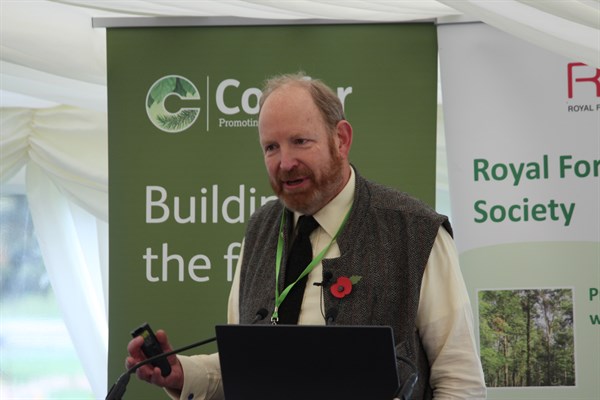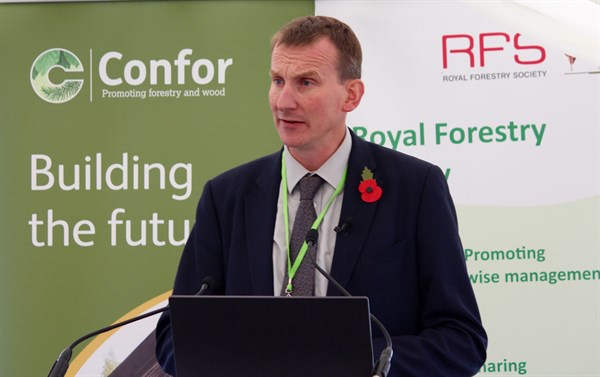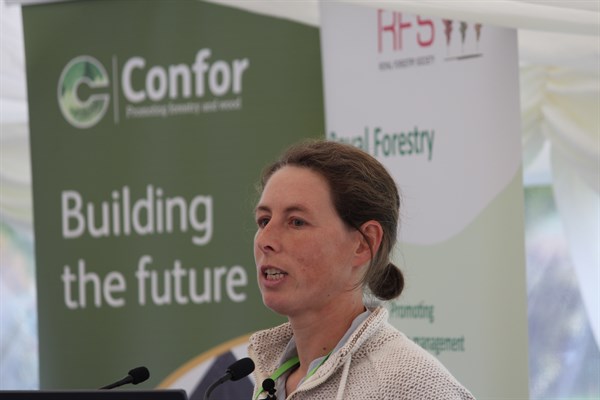Think of customer first to make woods pay
2 November 2016
The forestry sector must be prepared challenge conventional thinking and put the customer first if it is to make woodlands pay, a major conference heard.
2 November 2016
The forestry sector must be prepared challenge conventional thinking and put the customer first if it is to make woodlands pay, a major conference heard.
Keith Blacker, of manufacturer Edistone of Llanfyllin, said: “The forestry sector tends to look at planting a tree first and thinking about what the customer wants last. What it should be doing is asking what the customer wants first and then planting a tree."
Mr Blacker also described how he had brought experience from the automotive and telecoms industries to his small construction business at the conference, Making Woodlands Pay, organised by Confor and the Royal Forestry Society. The event also heard calls for a stronger focus on diversity and quality to deliver economically successful woodlands – and an open-minded, flexible approach to how to derive income from forests.


Forestry Commission Chairman, woodland owner and investment adviser Sir Harry Studholme made a similar point to Keith Blacker, saying “producing what people want” had to be a primary consideration for all forest owners. He also stressed the importance of good professional advice, the right species choice and weed and pest control [as well as persistence and optimism], adding: “If you make mistakes, you will live with them for decades.”
Sir Harry said the UK forestry sector had to be aware of the impact of global trends, especially the fact that China – already by far the world’s largest timber importer – would require more imports in future when logging in its national forests ends in 2017. “Inexorable demand will fuel an enormous demand for timber,” he said.
Speakers also discussed the potential impact of Brexit. Oliver Combe, of Timber Auctions, said: “Our world was turned upside down by Brexit but it does create opportunities.” A sluggish market in late 2015 had transformed within a year, with sawmills busy and looking for timber and investing in increased capacity, he added. Prices for good-quality timber were strong, with the pound likely to remain weak for 5-10 years – and if the pound continued to fall and reached parity with the Euro, Mr Combe thought we might see rising UK timber exports, possibly some of them to China.
Mr Combe warned the post-Brexit impact of rising import prices [the UK still imports 60 per cent of its timber] would not be felt until early 2017 as mills liked to have six months of timber supply paid ahead. However, importers could be looking for price rises of around 15-18 per cent in the first half of next year, he warned.
Mr Combe said planting trends bore no relation to market demand. “We produce 12 million tonnes of softwoods annually in the UK and 500,000 tonnes of hardwood. That [much greater demand for softwood] does not represent what is happening with planting – we are planting more hardwood, which the market does not really want.”
Sir Harry said it was “a real challenge” to ensure continued productive planting and warned of a hardwood glut, with the 500,000 tonnes likely to rise to 3 million tonnes due to planting policies. Despite the rise in woodfuel demand, it would be tough to find markets for so much hardwood, he argued.


Oliver Combe said firewood markets, which had been “fantastic” for the forestry sector before tailing off due to imports and cheap oil, showed signs of bouncing back. Justin Mumford of Lockhart Garrett agreed, saying firewood had been a “fundamental game-changer for lowland forestry”, with prices rising from around £2 to £22 per tonne – but he warned against complacency as half of UK internet firewood buyers were supplied with wood from abroad.
Mr Combe urged producers to diversify their markets and recover higher value from hardwood, not just “mash it up” into firewood. He added: “Quality is critical. If you have the quality, you can go up the value scale. Effective marketing is important; you need to understand what you are selling.”
Justin Mumford thought woodland owners were becoming more savvy about marketing and said “a good quality brand and delivery to the end user allows you to gain a premium price”. However, he warned owners to invest early in the process to make woodlands pay - in mechanization, plant protection and especially infrastructure, which could save money further down the line on planting, maintenance and thinning.
Despite the uncertainty of Brexit, Mr Mumford thought grants were here to stay in forestry, especially as the government was looking increasingly at the sector’s wider benefits, including flood alleviation, climate change mitigation, soil management and biodiversity. He also stressed the growing importance of deriving an income from trees when “standing and alive” via recreational opportunities (like Go Ape and paintball centres) and the Woodland Carbon Code, which placed a new value on timber.
Jenny Wong, an expert on non-timber forest products (NTFP), described the vast range options to develop an income from forests that did not involve wood. There was the potential to sell into the mass markets beyond wood – for example, by gathering moss in large quantities – and to develop smaller, niche businesses driven by innovation, and to offer ‘experiential products’. This might include bushcraft courses, fungi forays or basket weaving.
Dr Wong said there was a real growth opportunity, with the value of NTFPs across Europe estimated at 2.27 billion Euros annually by Adam Thorogood, of the Star-Tree Project.
Innovation was critical to create higher value product, Dr Wong stressed, but she said current potential income was relatively modest, mainly due to under-developed supply chains.


Ruth Pybus of Bron Haul, near Abergele, described how her interest in hazel basket weaving developed into a small business, along with other emerging projects including sweet chestnut posts. She praised the Bill Hogarth Memorial Apprenticeship Trust, which provides training in traditional coppicing skills – and suggested there was a tremendous opportunity to link Trust apprentices with unmanaged and under-managed woodland.
“These people can make a living out of completely neglected woodland but their big challenge is access to woodland in the first place. Perhaps Royal Forestry Society members could make use of the imagination and energy of the apprentices – and bring more woodland back into management as a result.”